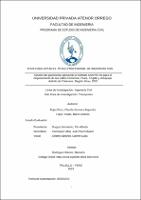Diseño del pavimento aplicando el método AASHTO 93 para el mejoramiento de las calles Comercio, Piura, Trujillo y Arequipa, distrito de Catacaos, Región Grau, 2022

Date
2024Author(s)
Rojas Pozo, Claudia Xiomara Alejandra
López Tirado, Marco Antonio
Metadata
Show full item recordAbstract
En el presente trabajo de investigación se diseñará según el método
AASTHO las calles Trujillo, Arequipa, Piura y Comercio en el Distrito de Catacaos.
En este caso, el estado actual de la sección de carretera estudiada se determina
primero utilizando el método PCI, que es una de las metodologías de pavimento
flexible y rígido más conocidas del mundo. Por lo tanto, la opción correctiva es
utilizar el método AASTHO en las cuatro calles de investigación para un proyecto
de calidad a largo plazo. Para ello se enumeraron todas las patologías existentes
en las muestras de estudio, resultando un total de 295 daños.
El estudio tiene como finalidad analizar el estado actual de la vía y realizar
el diseño para mejorar su serviciabilidad y transitabilidad, que cumpla con los
requisitos de diseño del método AASTHO.
La información recopilada ha sido cuidadosamente procesada para que este
informe pueda servir como referencia para futuras construcciones de avenidas e
importantes esfuerzos de investigación.
Se diseñó un pavimento flexible compuesto por una carpeta asfáltica con un
espesor de 6 cm, base de 20 cm y subbase de 15 cm, de acuerdo con los
lineamientos del método AASTHO 93 The present research work, the streets of Trujillo, Arequipa, Piura and
Comercio in the District of Catacaos will be designed according to the AASTHO
method. This case, the current state of the studied road section is first determined
using the PCI method, which is one of the best-known flexible and rigid pavement
methodologies in the world. Therefore, the corrective option is to use the AASTHO
method in all four research lanes for a quality long-term project. To do this, all
existing pathologies in the study samples were enumerated, resulting in a total of
295 damages. In the present research work, the streets of Trujillo, Arequipa, Piura
and Comercio in the District of Catacaos will be designed according to the AASTHO
method. In this case, the current state of the studied road section is first determined
using the PCI method, which is one of the best-known flexible and rigid pavement
methodologies in the world. Therefore, the corrective option is to use the AASTHO
method in all four research lanes for a quality long-term project. To do this, all
existing pathologies in the study samples were enumerated, resulting in a total of
295 damages.
Purpose of the study is analyze the current state of the road and carry out the
design to improve its serviceability and passability, which meets the design
requirements of the AASTHO method.
Information collected has been carefully processed so that this report can
serve as a reference for future road construction and major research efforts.
It is a flexible pavement composed of an asphalt layer with a thickness of 6
cm, a base of 20 cm and a sub base of 15 cm, according to the guidelines of the
AASHTO 93 method.
Subject
Collections
- Ingeniería Civil [1260]

